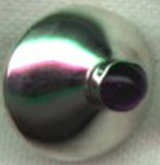The earliest buttons date to prehistoric times, and in spite of millennia of change in fashion and manufacturing techniques, the button has endured as the most common fabric fastener. Though buttons were used for thousands of years, the buttonhole was not invented until sometime in the 13th century.
The Greeks, although they had no word for button, did, like the Romans, use them for decoration. However, at some point, someone thought the button might make a nifty fastener. To this end, they ran the button through a little loop of thread and thereby created a use for the button, alongside the pin or the brooch, to keep garments together.
As clothing became more fitted, the button and loop became more attractive since it was less likely to cause injury than a pin. By around 1200, the button and buttonhole arrived in Europe, delivered, like many other things, by the returning Crusaders.
The first buttonholes were slits made in fabric just big enough to pass the button through, and this allowed tighter fitting clothing and inspired a fashion revolution.
The word button appeared at around this time and stems from either the French bouton for bud or bouter to push. Whatever the basis for the word, the French were quick to spot the potential of the button and by 1250 had established the Button Makers Guild. The Guild produced beautiful buttons with great artistry, much to the delight of the aristocracy. The peasants, however, were not allowed to join this button fest, even if they could afford it.
The aristocracy passed laws to limit buttons permitted for common usage to thread- or cloth-covered buttons. As a result, the button became a status symbol, and it was not discrete; buttons were being used like there was no tomorrow - not just for fastening clothes but, once more, as adornment.
By the middle of the 1300s buttons were big business and people loved them. Tailors produced garments with row upon row of buttons with matching
buttonholes. France, by this time, was the button capital of Europe and the Guild made considerable profit producing buttons for coats, dresses and
anything that looked as if it needed a button. Europe was so button crazy that even the Church got in on the act and denounced them
as the devil's snare
, seemingly referring to the ladies in their button-fronted dresses.
This attraction for buttons resulted in some outfits adorned with thousands of buttons, all of them with accompanying buttonholes. Dressing and undressing became a chore, but created a niche for the employment of professional dressers. Button mania ran on unabated, and in 1520 reports tell of a meeting where King Francis I of France, his clothing bedecked with some 13,600 buttons, met King Henry VIII of England, similarly weighed down with buttons.

The button mania could not last forever though, and with the Puritans condemning it as sinful, in the 16th Century its popularity began to wane to more sensible levels. That's not to say they weren\'t still very much in vogue; it's just that the number of buttons required to be at the height of fashion diminished. In response to this, the button-makers took to making more and more elaborate buttons. These artisans made their fancy buttons from precious materials like gold, ivory and even diamond.


